Fracture Behavior of Crack-Damaged Concrete Beams Reinforced with Ultra-High-Performance Concrete Layers
Abstract
1. Introduction
- a.
- There needs to be deeper investigation into the fracture toughness of U+NC beams.
- b.
- Quantitative formulas for calculating the ductility of U+NC are absent.
- c.
- Interfacial bond–slip properties are less often considered in simulations (mostly treated as a perfect connection or a constant is specified).
2. Methods
2.1. Double-K Fracture Criterion
- (1)
- SNC
- (2)
- U+SNC
2.2. XFEM Crack Tip Processing Theory
- (1)
- XFEM crack tip processing theory
- (2)
- XFEM case validation
3. Finite Element Modeling of U+SNC
3.1. Geometric Model
3.2. Interface Model
3.3. XFEM Model
3.4. Workflows
4. Analysis of Results
4.1. Crack Extension Process
4.2. Effect of UHPC Layer Thickness on Fracture Performance of U+SNC Beams
4.3. Effect of Crack Height Ratio on Fracture Toughness of Reinforced Beams
4.4. Effect of VSF on Fracture Toughness of U+SNC
5. Results and Outlook
- (1)
- The XFEM method can accurately and reliably predict the crack extension trend and fracture parameters of materials;
- (2)
- The load-carrying capacity and toughness of the UHPC significantly increased with d, and the optimal d was 20 mm, allowing for the combined effects of self-weight of U+SNC and gain cost of the UHPC layer;
- (3)
- With a constant d, increasing a/h results in a modest improvement in the structural fracture performance of U+SNC;
- (4)
- As VSF increases, the U+SNC beam exhibits a smoother crack extension phase and higher toughness and flexural properties, where the best are achieved at a VSF of 3%.
Author Contributions
Funding
Data Availability Statement
Acknowledgments
Conflicts of Interest
Abbreviations
| Full Name | Abbreviation |
| Ultra-high-performance concrete | UHPC |
| Finite element method | FEM |
| Crack mouth opening displacement | CMOD |
| Steel fiber | SF |
| UHPC-reinforced single-notched concrete beam | U+SNC |
| Extended finite element method | XFEM |
| Critical CMOD | CMODc |
| Crack height ratio | a/h |
References
- Dai, J.; Huang, B.; Shah, S.P. Recent advances in strain-hardening UHPC with synthetic fibers. J. Compos. Sci. 2021, 5, 283–291. [Google Scholar] [CrossRef]
- Ogaili, A.A.F.; Basem, A.; Kadhim, M.S.; Al-Sharify, Z.T.; Jaber, A.A.; Njim, E.K.; Al-Haddad, L.A.; Hamzah, M.N.; Al-Ameen, E.S. The effect of chopped carbon fibers on the mechanical properties and fracture toughness of 3d-printed PLA parts: An experimental and simulation study. J. Compos. Sci. 2024, 8, 273. [Google Scholar] [CrossRef]
- Wei, Y.; Chen, K.; Kang, J.; Chen, W.; Wang, X.; Zhang, X. Policy and management of carbon peaking and carbon neutrality: A literature review. Engineering 2022, 14, 52–63. [Google Scholar] [CrossRef]
- Al-Osta, M.A.; Isa, M.N.; Baluch, M.H.; Rahman, M.K. Flexural behavior of reinforced concrete beams strengthened with ultra-high performance fiber reinforced concrete. Constr. Build. Mater. 2017, 134, 279–296. [Google Scholar] [CrossRef]
- Gao, X.; Yin, C.; Guo, J.; Chen, G.; Huang, H. Experimental and theoretical study on the shear behaviors of an innovative precast UHPC composite beams reinforced with inverted t-shaped steel. J. Build. Eng. 2024, 96, 110504. [Google Scholar] [CrossRef]
- Hou, C.; Ma, G.; Hwang, H.; Li, S.; Kang, S. Seismic retrofit of intact and damaged RC columns using prefabricated steel cage-reinforced UHPC jackets and nsm gfrp bars. Eng. Struct. 2024, 317, 118665. [Google Scholar] [CrossRef]
- Lampropoulos, A.P.; Paschalis, S.A.; Tsioulou, O.T.; Dritsos, S.E. Strengthening of reinforced concrete beams using ultra high performance fibre reinforced concrete (UHPFRC). Eng. Struct. 2016, 106, 370–384. [Google Scholar] [CrossRef]
- Paschalis, S.A.; Lampropoulos, A.P.; Tsioulou, O. Experimental and numerical study of the performance of ultra-high performance fiber reinforced concrete for the flexural strengthening of full scale reinforced concrete members. Constr. Build. Mater. 2018, 186, 351–366. [Google Scholar] [CrossRef]
- Ramachandra Murthy, A.; Karihaloo, B.L.; Priya, D.S. Flexural behavior of RC beams retrofitted with ultra-high strength concrete. Constr. Build. Mater. 2018, 175, 815–824. [Google Scholar] [CrossRef]
- Taffese, W.Z.; Zhu, Y.; Chen, G. Ensemble-learning model based ultimate moment prediction of reinforced concrete members strengthened by UHPC. Eng. Struct. 2024, 305, 117705. [Google Scholar] [CrossRef]
- Xu, T.; Yang, J.; Wang, C.; Guo, T.; Deng, K.; Xie, T. Comparative sustainability and seismic performance analysis of reinforced conventional concrete and UHPC bridge piers. J. Clean. Prod. 2024, 467, 142959. [Google Scholar] [CrossRef]
- Ding, Y.; Zhou, Z.; Wei, Y.; Zhou, S. Experimental study and efficient shear-flexure interaction model of reinforced concrete shear walls with UHPC boundary columns. Case Stud. Constr. Mater. 2024, 20, e3059. [Google Scholar] [CrossRef]
- Hung, C.; Agrawal, S.; Hsiao, H. Rehabilitation of seismically-damaged RC beam-column joints with UHPC and high-strength steel mesh reinforcement. J. Build. Eng. 2024, 84, 108667. [Google Scholar] [CrossRef]
- Ding, Y.; Zeng, B.; Zhou, Z.; Wei, Y.; Zhu, M. Seismic retrofitting of RC columns using stainless steel grid-reinforced UHPC jackets in plastic hinge zone. J. Build. Eng. 2024, 84, 108637. [Google Scholar] [CrossRef]
- Su, Y.; Wu, C.; Shang, J.; Zhang, P.; Sheikh, S.A. Experimental and numerical simulation research on the flexural performance of beams reinforced with GFRP bars and three-sides UHPC layer. Structures 2024, 59, 105746. [Google Scholar] [CrossRef]
- Gao, X.; Wu, K.; Guo, Y.; Zhao, Y.; Guo, J. Experimental and numerical study on flexural behaviors of damaged RC beams strengthened with UHPC layer using the bonding technology of post-installed reinforcing bar. Constr. Build. Mater. 2023, 391, 131835. [Google Scholar] [CrossRef]
- Men, P.; Di, J.; Qin, F.; Huang, S.; Huang, Z.; Peng, X. Bending behaviour of reinforced concrete t-beams damaged by overheight vehicle impact strengthened with ultra-high performance concrete (UHPC). Case Stud. Constr. Mater. 2024, 21, e3393. [Google Scholar] [CrossRef]
- Al-Shawafi, A.; Zhu, H.; Bo, Z.; Haruna, S.I.; Ibrahim, Y.E.; Farouk, A.I.B.; Laqsum, S.A.; Shao, J. Bond behavior between normal concrete and UHPC and puc layers subjected to different loading conditions coupled with fracture analysis technique. J. Build. Eng. 2024, 86, 108880. [Google Scholar] [CrossRef]
- Wu, C.; Ma, G.; Hwang, H.J. Bond performance of spliced gfrp bars in pre-damaged concrete beams retrofitted with cfrp and uhpc. Eng. Struct. 2023, 292, 116523. [Google Scholar] [CrossRef]
- Safdar, M.; Matsumoto Kakuma, K. Flexural behavior of reinforced concrete beams repaired with ultra-high performance fiber reinforced concrete (UHPFRC). Compos. Struct. 2016, 157, 448–460. [Google Scholar] [CrossRef]
- Dang, Q. Study on flexural behavior of damaged deck strengthened with Ultra High Performance Concrete; Hunan Univ.: Guangxi, China, 2016. (In Chinese) [Google Scholar]
- Liu, T.; Charron, J. Determination of NSC-UHPC interface properties for numerical modeling of UHPC-strengthened concrete beams and slabs. Eng. Struct. 2023, 290, 116385. [Google Scholar] [CrossRef]
- Huang, Y.; Lee, M.; Kan, Y.; Wang, W.; Wang, Y.; Pan, W. Reinforced concrete beams retrofitted with UHPC or CFRP. Case Stud. Constr. Mater. 2022, 17, e1507. [Google Scholar] [CrossRef]
- Hung, C.C.; El-Tawil, S.; Chao, S.H. A review of developments and challenges for UHPC in structural engineering: Behavior, analysis, and design. J. Struct. Eng. 2021, 147, 03121001. [Google Scholar] [CrossRef]
- Figiela, B.; Simonova, H.; Korniejenko, K. State of the art, challenges, and emerging trends: Geopolymer composite reinforced by dispersed steel fibers. Rev. Adv. Mater. Sci. 2022, 61, 1–15. [Google Scholar] [CrossRef]
- Zhu, Y.; Zhang, Y.; Hussein, H.H.; Chen, G.D. Flexural strengthening of reinforced concrete beams or slabs using ultra-high performance concrete (UHPC): A state of the art review. Eng. Struct. 2020, 205, 110035. [Google Scholar] [CrossRef]
- Wei, J.; Li, J.; Wu, C.; Hao, H.; Liu, J. Experimental and numerical study on the impact resistance of ultra-high performance concrete strengthened RC beams. Eng. Struct. 2023, 277, 115474. [Google Scholar] [CrossRef]
- Mukhtar, F.; El-Tohfa, A. A review on fracture propagation in concrete: Models, methods, and benchmark tests. Eng. Fract. Mech. 2023, 281, 109100. [Google Scholar] [CrossRef]
- Tao, X.J.; Luo, J.L.; Zhang, J.G.; Zhu, M.; Zhang, L.Q.; Gao, Y.B. Progress in FEM modeling on mechanical and electromechanical properties of carbon nanotube cement-based composites. Nanotechn. Rev. 2023, 12, 20220522. [Google Scholar]
- Kuang, Y.; Wang, Y.; Xiang, P.; Tao, L.; Wang, K.; Fan, F.; Yang, J. Experimental and theoretical study on the fatigue crack propagation in stud shear connectors. Materials 2023, 16, 701. [Google Scholar] [CrossRef]
- Tawfik, A.B.; Mahfouz, S.Y.; Taher, S.E.D.F. Nonlinear ABAQUS simulations for notched concrete Beams. Materials 2021, 14, 7349. [Google Scholar] [CrossRef]
- Li, Y.C. Crack Propagation Analysis of Concrete Members Based on Extended Finite Element Method. Master’s Thesis, Guangxi University of Science and Technology, Guangxi, China, 2018. (In Chinese). [Google Scholar]
- Zhou, J.; Xia, G.; Wang, P.; Zhao, J.; Xu, L.; Pan, J. Investigation of flexural cracks in engineered cementitious composites beams reinforced with CFRP bars. Constr. Build. Mater. 2024, 438, 136900. [Google Scholar] [CrossRef]
- He, S.; Mustafa, S.; Chang, Z.; Liang, M.; Schlangen, E.; Luković, M. Ultra-thin Strain Hardening Cementitious Composite (SHCC) layer in reinforced concrete cover zone for crack width control. Eng. Struct. 2023, 292, 116584. [Google Scholar] [CrossRef]
- Yin, X.; Li, Q.; Wang, Q.; Reinhardt, H.; Xu, S. The double-K fracture model: A state-of-the-art review. Eng. Fract. Mech. 2023, 277, 108988. [Google Scholar] [CrossRef]
- Gao, X.; Ji, M.; Li, Q.; Zhou, M.; Yang, C.; Liu, Z. Prediction of fracture failure and fracture parameters for dam gallery concrete specimens of arbitrary size and age via boundary effect model and fracture extreme theory. Theor. Appl. Fract. Mech. 2024, 131, 104376. [Google Scholar] [CrossRef]
- Xie, H.; Yang, L.; Li, J.; Chen, Z.; Zhang, F.; Liu, Y.; Sui, Z.; Zhang, Q. Research on mode-I fracture characteristics of basalt fiber reactive powder concrete. J. Build. Eng. 2023, 80, 108159. [Google Scholar] [CrossRef]
- DL/T5332-2005; Norm for Fracture Test of Hydraulic Concrete. Hohai University, China Power Industry Standards: Beijing, China, 2005. (In Chinese)
- Lei, Z.P. Numerical Study on Cracking Behavior of Concrete Beams Based on Extended Finite Element Method. Master’s Thesis, South China University of Technology, Guangzhou, China, 2017. (In Chinese). [Google Scholar]
- Zhu, Y.; Xu, S.L. Study on fracture process of concrete three-point bending beams retrofitted with UHTCC. Eng. Mech. 2011, 28, 69–77. [Google Scholar]
- Wu, M.Y.; Zhang, D.M.; Li, M.H. An ABAQUS crack extension data extraction method, system and computer-readable storage medium. CN201910688214.5, 2 May 2023. (In Chinese). [Google Scholar]
- Liu, X.Q.; Xie, J.J.; Wu, X. An internal crack extension modeling method for finite element analysis of structures. CN201910017825.7, 5 July 2022. (In Chinese). [Google Scholar]
- Feng, W.; Xu, F.; You, H.; Li, M.L. Adhesive damage and defect analysis of scarf-repaired composite by combining extended finite element method and cohesive zone model. Acta Mater. Compos. Sin. 2018, 35, 1354–1360. [Google Scholar]
- Zaim, O.; Sugiman, S.; Hazrina, M.; Hilton, A. Utilizing XFEM model to predict the flexural strength of woven fabric Kenaf FRP plate strengthened on plain concrete beam. Case Stud. Constr. Mater. 2023, 18, e2056. [Google Scholar]
- El-Tohfa, A.; Mukhtar, F. Fracture and size effect analysis in concrete using 3-D G/XFEM and a CZM-LEFM correlation model: Validation with experiments. Comp. Struct. 2023, 282, 107043. [Google Scholar] [CrossRef]
- Jin, H.; Yu, S. Study on corrosion-induced cracks for the concrete with transverse cracks using an improved CDM-XFEM. Constr. Build. Mater. 2022, 318, 126173. [Google Scholar] [CrossRef]
- Carmona, J.R.; Ruiz, G.; Del Viso, J.R. Mixed-mode crack propagation through reinforced concrete. Eng. Fract. Mech. 2007, 74, 2788–2809. [Google Scholar] [CrossRef]
- Hu, S.W.; Mi, Z.X. Numerical simulation of concrete crack propagation process on extended finite element method. J. Hydraul. Eng. 2014, 45, 51–56. [Google Scholar]
- Zhu, Y.; Zhang, Y.; Hussein, H.H.; Chen, G.D. Numerical modeling for damaged reinforced concrete slab strengthened by ultra-high performance concrete (UHPC) layer. Eng. Struct. 2020, 209, 110031. [Google Scholar] [CrossRef]
- Zhang, Z.; Shao, X.D.; Li, W.G.; Zhu, P.; Chen, H. Axial Tensile Behavior Test of Ultra High Performance Concrete. China J. Highway Transp. 2015, 28, 50–58. (In Chinese) [Google Scholar]
- Yang, J. Flexural Behavior of Ultra-High Performance Concrete Beams Prestressed with CFRP Tendons. Ph.D. Thesis, Hunan University, Hunan, China, 2007. (In Chinese). [Google Scholar]
- Zhou, J.T.; Zhou, L.; Yang, J.; Wang, Z.S. Summarization on bonding behaviors of ultra-high performance concrete and normal concrete. J. Jiangsu Uni. (Nat. Sci. Ed.) 2020, 41, 373–381. (In Chinese) [Google Scholar]
- Yang, Y.; Xu, C.; Yang, J.; Wang, K. Experimental study on flexural behavior of precast hybrid UHPC-NSC beams. J. Build. Eng. 2023, 70, 106354. [Google Scholar] [CrossRef]
- Feng, S.; Shi, X.B.; Wang, W.; Xu, F.; Xiao, H.G. Research on evaluation method of UHPC-NSC bond strength. J. Build. Mater. 2023, 26, 1220–1228. [Google Scholar]
- Gao, S.L.; Guo, Y.D.; Wu, Y.Q.; Qiu, H.F. Experimental study and simulation analysis on the flexural capacity of high strength reinforced concrete/ECC composite beams. Build. Sci. 2017, 33, 44–51. (In Chinese) [Google Scholar]
- Guo, W.Q.; Wei, Y.; Ma, L.; Liu, Y.L.; Guo, R.X. Effect of grouped L-shape rebar connectors on the shrinkage behavior of UHPC overlay cast on hardened NSC substrate. Constr. Build. Mater. 2023, 382, 131319. [Google Scholar] [CrossRef]
- Hussein, H.H.; Walsh, K.K.; Sargand, S.M.; Al, R.F.T.; Steinberg, E.P. Modeling the shear connection in adjacent box-beam bridges with ultrahigh-performance concrete joints. i: Model calibration and validation. J. Bridg. Eng. 2017, 22, 4017043. [Google Scholar] [CrossRef]
- Greco, F.; Barendrecht, P.; Coox, L.; Atak, O.; Desmet, W. Finite element analysis enhanced with subdivision surface boundary representations. Finite Elem. Anal. Des. 2017, 137, 56–72. [Google Scholar] [CrossRef]
- Gibert, G.; Prabel, B.; Gravouil, A.; Jacquemoud, C. A 3D automatic mesh refinement X-FEM approach for fatigue crack propagation. Finite Elem. Anal. Des. 2019, 157, 21–37. [Google Scholar] [CrossRef]
- Wu, C.; He, X.; Wu, W.; Ji, K. Low cycle fatigue crack propagation and damage evolution of concrete beams reinforced with gfrp bar. Compos. Struct. 2023, 304, 116312. [Google Scholar] [CrossRef]
- Zhang, K.; Shen, X.; Liu, J.; Teng, F.; Zhang, G.H.; Wang, J.W. Flexural strengthening of reinforced concrete T-beams using a composite of prestressed steel wire ropes embedded in polyurethane cement (PSWR-PUC): Theoretical analysis. Structures 2022, 44, 1278–1287. [Google Scholar] [CrossRef]
- Ombres, L. Flexural analysis of reinforced concrete beams strengthened with a cement based high strength composite material. Compos. Struct. 2011, 94, 143–155. [Google Scholar] [CrossRef]
- Shirai, K.; Yin, H.; Teo, W. Flexural capacity prediction of composite RC members strengthened with UHPC based on existing design models. Structures 2020, 23, 44–55. [Google Scholar] [CrossRef]
- Tran, D.A.; Shen, X.; Sorelli, L.; Ftima, M.B.; Brühwiler, E. Predicting the effect of non-uniform fiber distribution on the tensile response of ultra-high-performance fiber reinforced concrete by magnetic inductance-based finite element analysis. Cem. Concr. Compos. 2023, 135, 104810. [Google Scholar] [CrossRef]
- Nguyen, D.; Le, H.; Vu, T.; Tran, N.T. Evaluating fracture characteristics of ultra-high-performance fiber-reinforced concrete in flexure and tension with size impact. Constr. Build. Mater. 2023, 382, 131224. [Google Scholar] [CrossRef]
- Dastgerdi, A.S.; Peterman, R.J.; Savic, A.; Riding, K.; Beck, B.T. Prediction of splitting crack growth in prestressed concrete members using fracture toughness and concrete mix design. Constr. Build. Mater. 2020, 246, 118523. [Google Scholar] [CrossRef]
- Wu, Y.X.; Zheng, X.Y.; Huang, W.; Zheng, X.Y.; Chen, B.C. Review of interface bond behavior between ultra-high performance concrete and existing concrete. Mater. Rep. 2023, 37, 21120057. (In Chinese) [Google Scholar]
- Prem, P.R.; Murthy, A.R.; Verma, M. Theoretical modelling and acoustic emission monitoring of RC beams strengthened with UHPC. Constr. Build. Mater. 2018, 158, 670–682. [Google Scholar] [CrossRef]

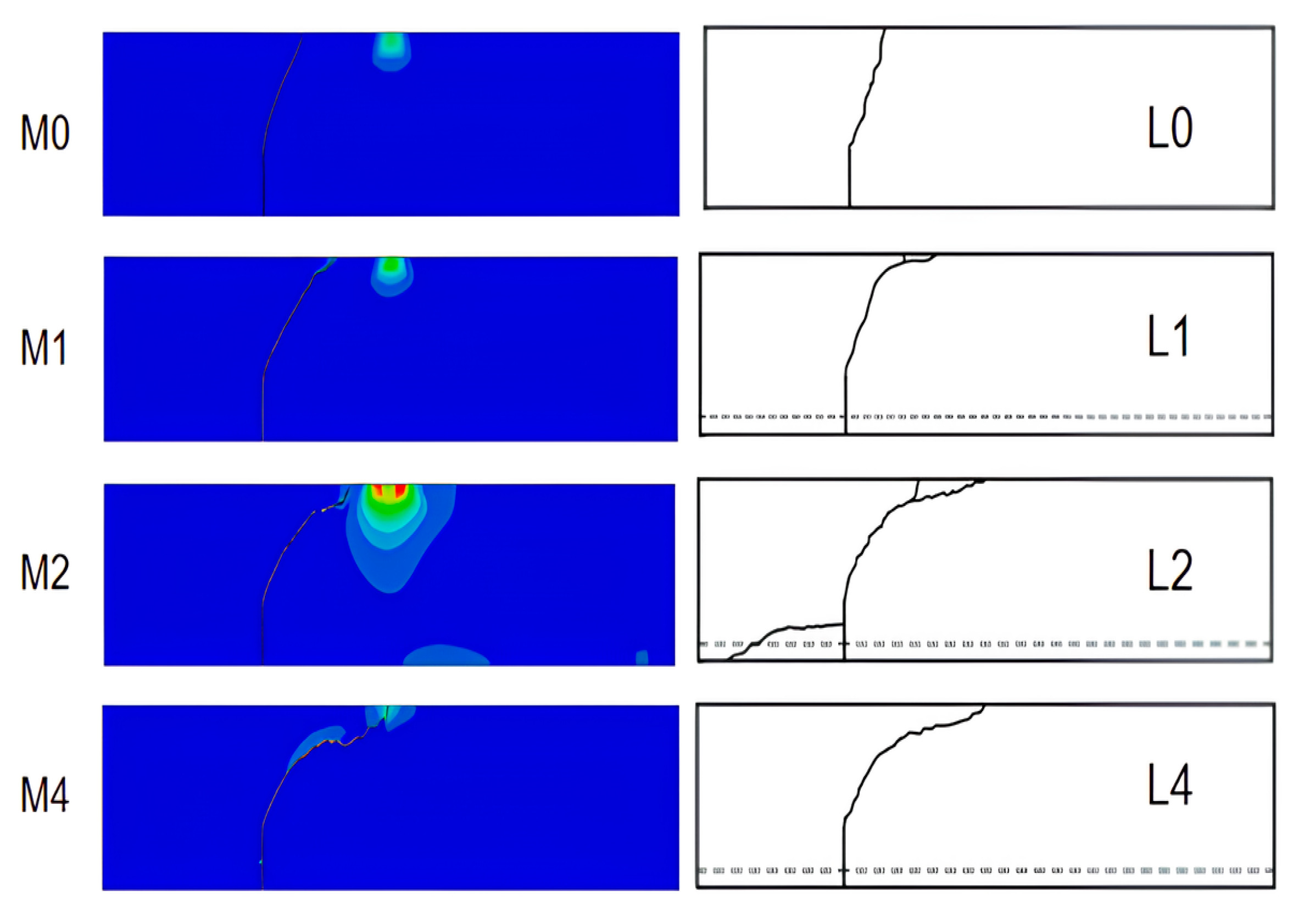

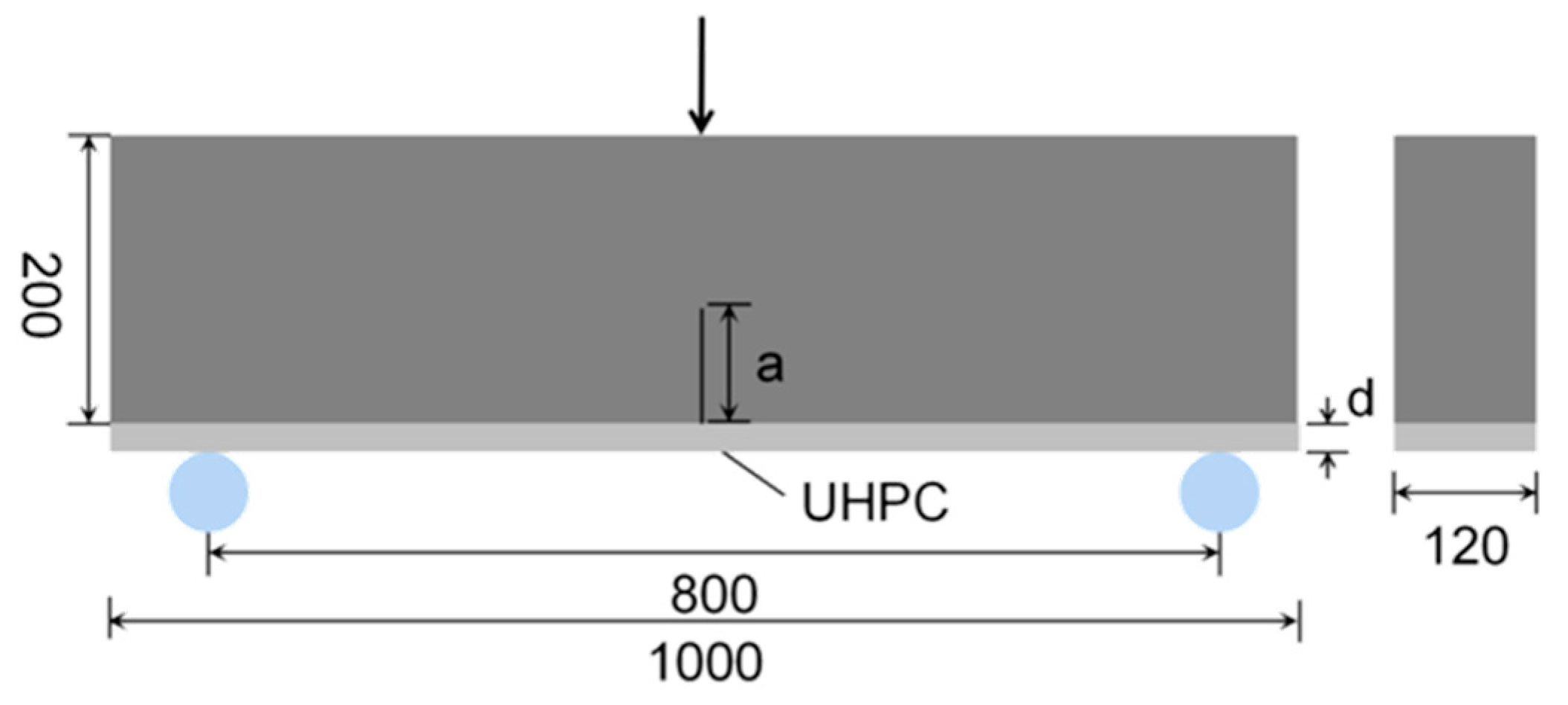
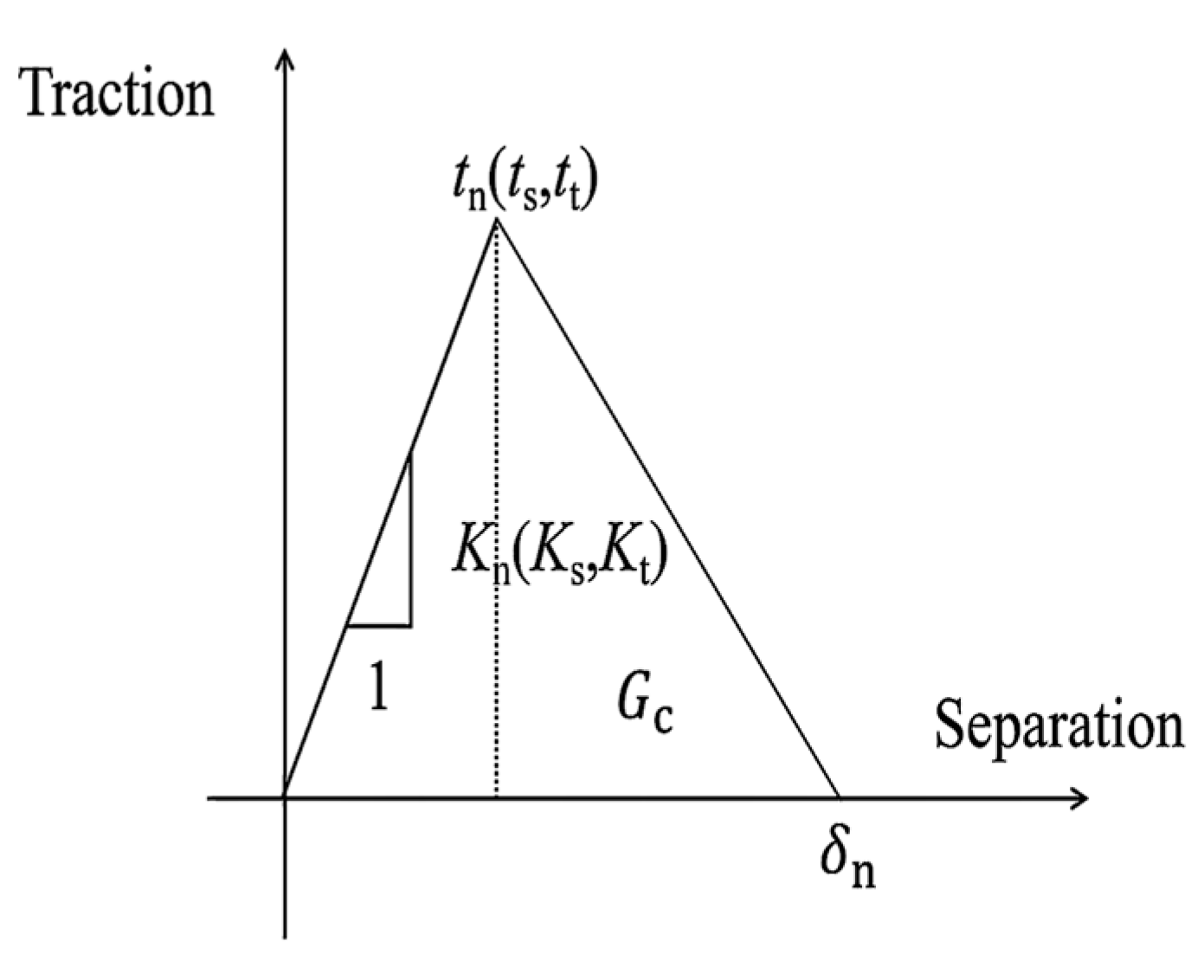
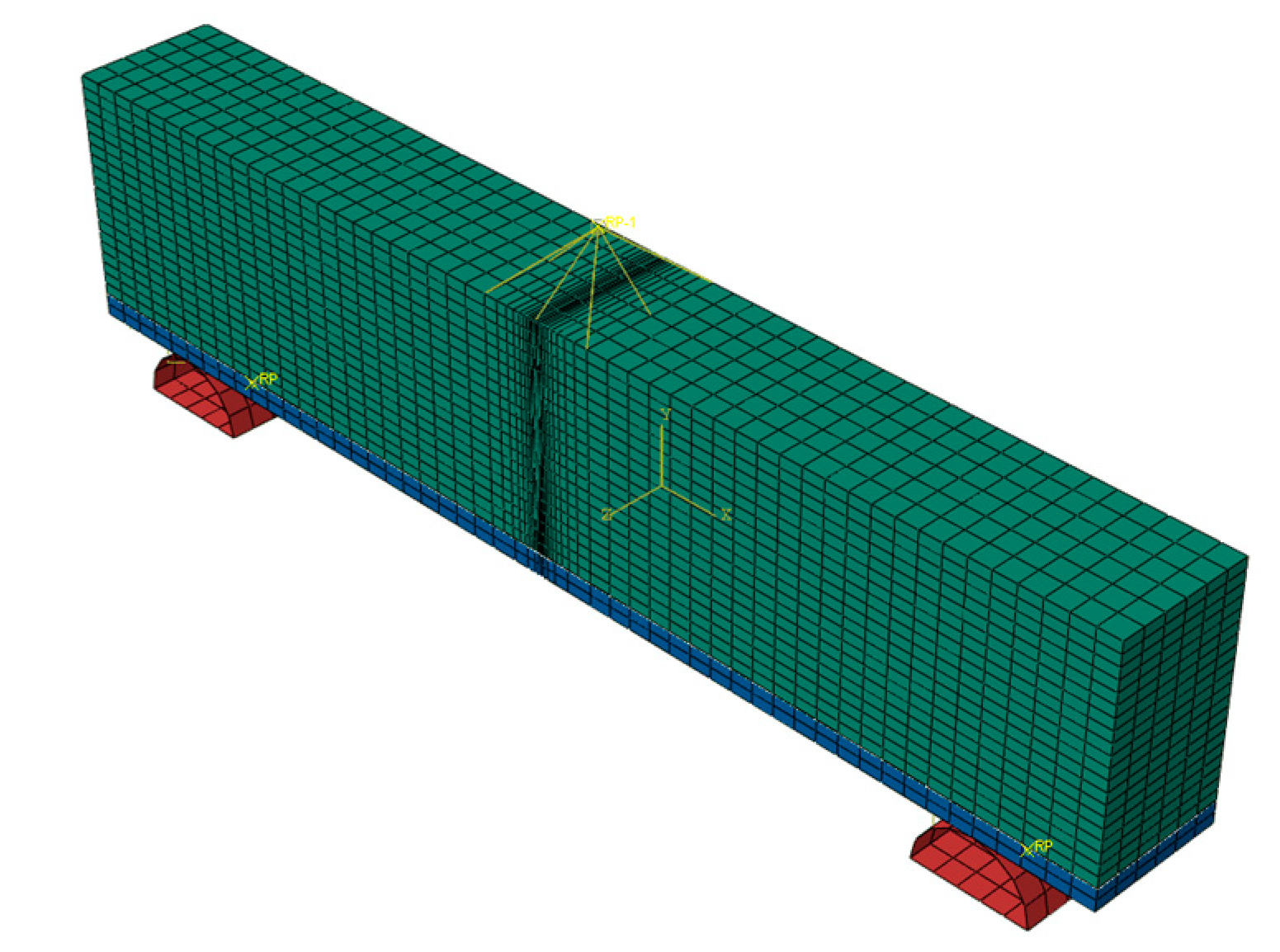



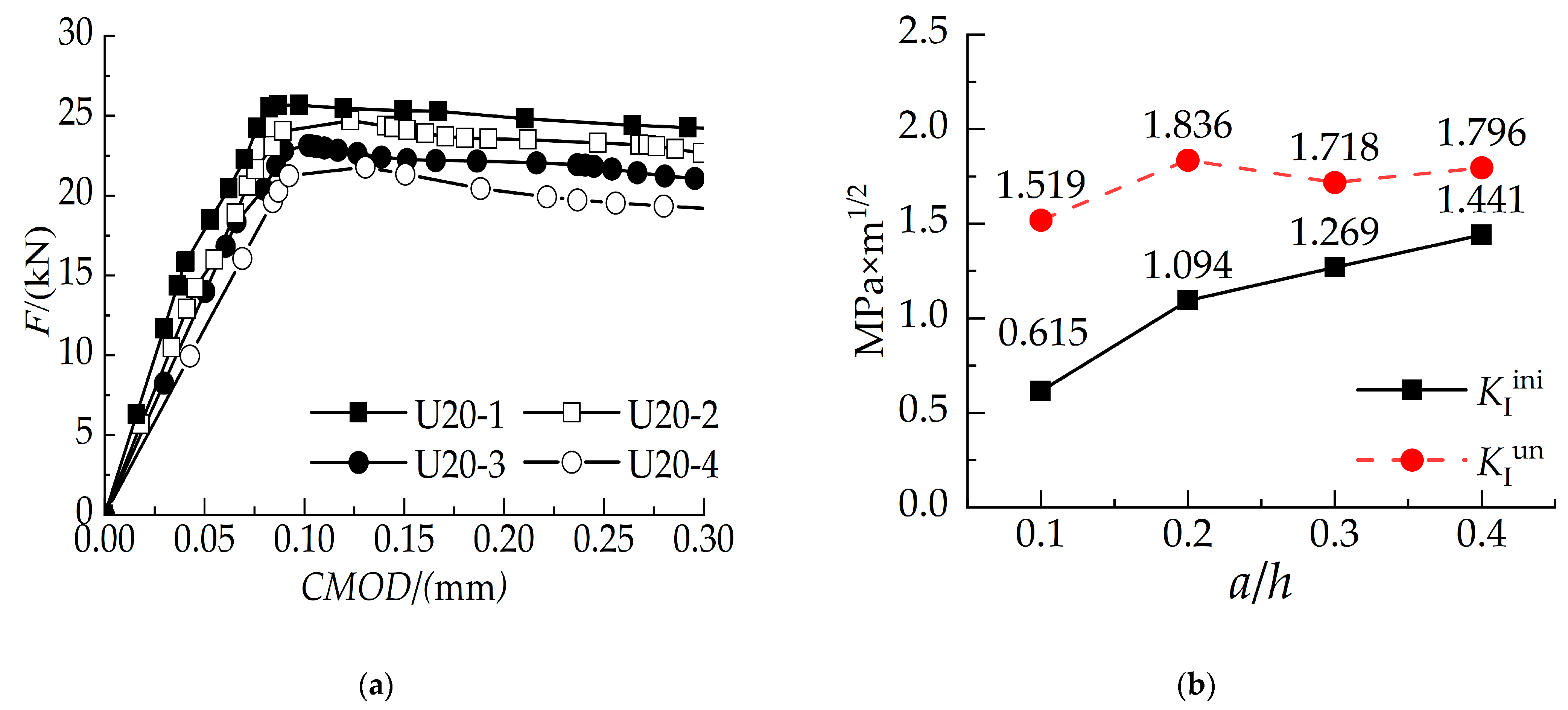
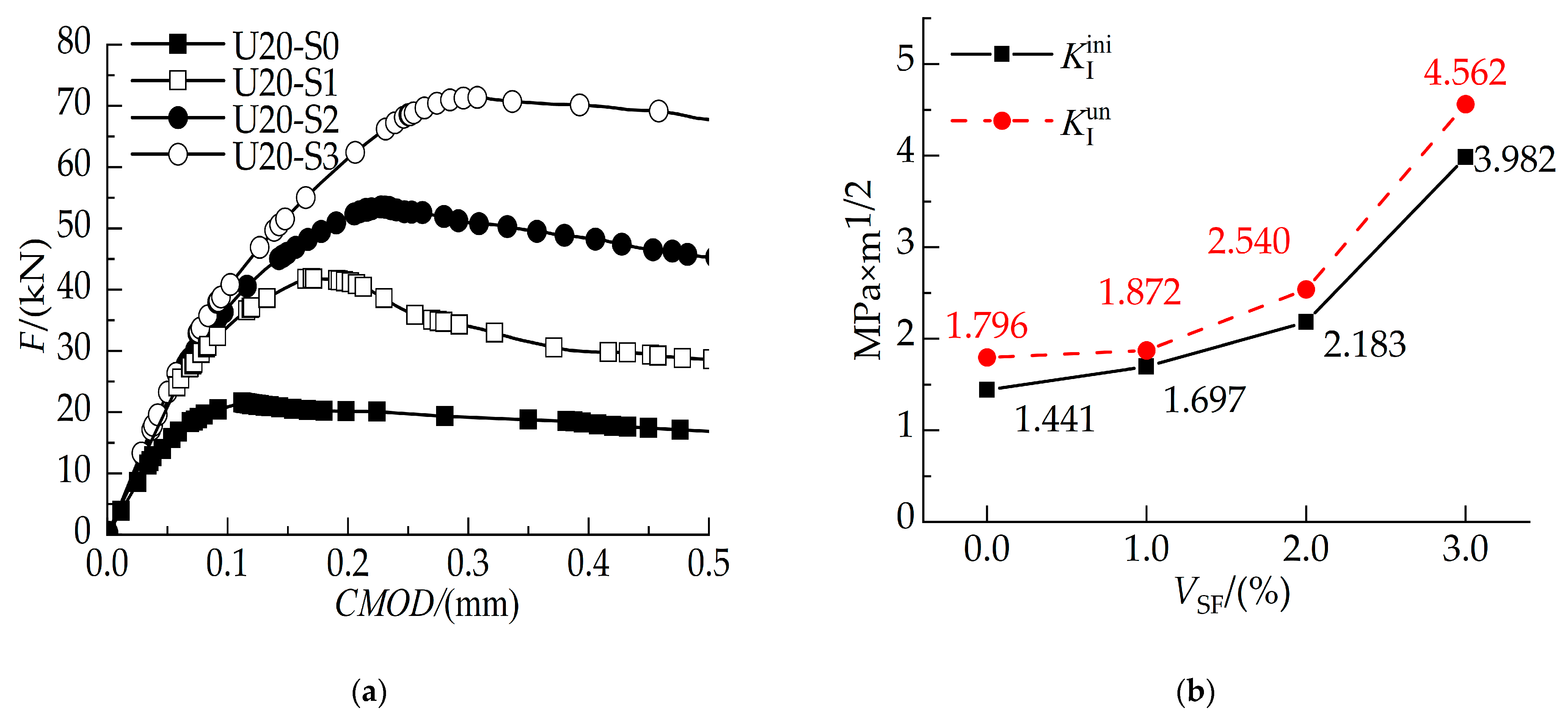
| Ref. | Size/(mm) | Thickness of UHPC/(mm) | Software | The Constitutive Relationship |
|---|---|---|---|---|
| [4] | 1600 × 140 × 230 | 30 | Abaqus | CDP |
| [7] | 2200 × 150 × 250 | 50 | Atena | SBETA |
| [8] | 2200 × 150 × 200 | 30/50/70 | Atena | SBETA |
| [9] | 1500 × 100 × 200 | 10 | Abaqus | CDP |
| [20] | 3000 × 250 × 400 | 40/80 | Msc | Macgegor |
| [21] | 3200 × 2000 × 280 | 50 | Msc | MacGegor |
| [22] | 1600 × 150 × 250 | 50 | Atena | SBETA |
| Materials | Density/ ) | Elastic Modulus/ (GPa) | Poisson’s Ratio | Ultimate Tensile Strength/ (MPa) | Rupture Energy/ (N/m) |
|---|---|---|---|---|---|
| NC | 2400 | 28.3 | 0.2 | 3.8 | 43.4 |
| Rebar | 7800 | 174 | 0.3 | - | - |
| Specimen | /(kN) | Errors | CMOD/(mm) | Errors |
|---|---|---|---|---|
| M0 | 6.253 | 2% | 0.0536 | / |
| L0 | 6.103 | — | ||
| M1 | 6.681 | 4% | 0.0605 | 3% |
| L1 | 6.434 | 0.0588 | ||
| M2 | 8.801 | 9% | 0.0953 | 11% |
| L2 | 8.043 | 0.0858 | ||
| M4 | 11.533 | 13% | 0.0875 | 14% |
| L4 | 10.231 | 0.0770 |
| Material Type | Density/ ) | Elastic Modulus/ (GPa) | Poisson’s Ratio | Ultimate Tensile Strength/ (MPa) | Rupture Energy/ (N/m) |
|---|---|---|---|---|---|
| Concrete | 2400 | 31.50 | 0.167 | 1.65 | 102.8 |
| UHPC | 2600 | 42.45 | 0.19 | 8.1 | 781.7 |
| Feature Parameters | Numerical Factor |
|---|---|
| ) | 1358 |
| 20,358 | |
| 5.63 | |
| (mm) | 0.241 |
| Stabilization | 0.001 |
| Friction coefficient | 1.44 |
| Spec. No. | U-10 | U-15 | U-20 | U-25 | |
|---|---|---|---|---|---|
| Parameter | |||||
| Fini/(kN) | 7.684 | 15.154 | 20.283 | 21.362 | |
| Fmax/(kN) | 11.812 | 16.629 | 21.791 | 28.297 | |
| Fini/Fmax | 0.651 | 0.911 | 0.931 | 0.755 | |
| 1.487 | 2.599 | 3.365 | 3.534 | ||
| / | 2.481 | 3.350 | 4.277 | 6.403 | |
| / | −0.965 | −1.444 | −1.924 | −2.278 | |
| / | −1.232 | −1.856 | −2.481 | −3.695 | |
| / | 0.522 | 1.155 | 1.441 | 1.255 | |
| / | 1.250 | 1.494 | 1.796 | 2.709 | |
| Spec. No. | U20-4 | U20-3 | U20-2 | U20-1 | |
|---|---|---|---|---|---|
| Parameter | |||||
| Fini/(kN) | 20.283 | 21.588 | 23.076 | 24.014 | |
| Fmax/(kN) | 21.791 | 23.151 | 24.703 | 25.667 | |
| Fini/Fmax | 0.931 | 0.932 | 0.934 | 0.936 | |
| 7.572 | 2.731 | 2.240 | 1.674 | ||
| / | 2.646 | 3.831 | 3.851 | 3.256 | |
| / | −1.924 | −1.462 | −1.146 | −1.059 | |
| / | −2.481 | −2.113 | −2.015 | −1.737 | |
| / | 1.441 | 1.269 | 1.094 | 0.615 | |
| / | 1.796 | 1.718 | 1.836 | 1.519 | |
| Spec. No. | U20-S0 | U20-S1 | U20-S2 | U20-S3 | |
|---|---|---|---|---|---|
| Parameter | |||||
| Fini(kN) | 20.283 | 37.025 | 45.945 | 62.419 | |
| Fmax(kN) | 21.791 | 41.881 | 53.495 | 71.381 | |
| Fini/Fmax | 0.931 | 0.884 | 0.859 | 0.874 | |
| 3.365 | 5.838 | 7.156 | 9.590 | ||
| 4.277 | 8.923 | 11.937 | 16.181 | ||
| −1.924 | −4.141 | −4.973 | −5.608 | ||
| −2.481 | −7.051 | −9.398 | −11.619 | ||
| 1.441 | 1.697 | 2.183 | 3.982 | ||
| 1.796 | 1.872 | 2.540 | 4.562 | ||
Disclaimer/Publisher’s Note: The statements, opinions and data contained in all publications are solely those of the individual author(s) and contributor(s) and not of MDPI and/or the editor(s). MDPI and/or the editor(s) disclaim responsibility for any injury to people or property resulting from any ideas, methods, instructions or products referred to in the content. |
© 2024 by the authors. Licensee MDPI, Basel, Switzerland. This article is an open access article distributed under the terms and conditions of the Creative Commons Attribution (CC BY) license (https://creativecommons.org/licenses/by/4.0/).
Share and Cite
Guo, Z.; Tao, X.; Xiao, Z.; Chen, H.; Li, X.; Luo, J. Fracture Behavior of Crack-Damaged Concrete Beams Reinforced with Ultra-High-Performance Concrete Layers. J. Compos. Sci. 2024, 8, 355. https://doi.org/10.3390/jcs8090355
Guo Z, Tao X, Xiao Z, Chen H, Li X, Luo J. Fracture Behavior of Crack-Damaged Concrete Beams Reinforced with Ultra-High-Performance Concrete Layers. Journal of Composites Science. 2024; 8(9):355. https://doi.org/10.3390/jcs8090355
Chicago/Turabian StyleGuo, Zenghui, Xuejun Tao, Zhengwei Xiao, Hui Chen, Xixi Li, and Jianlin Luo. 2024. "Fracture Behavior of Crack-Damaged Concrete Beams Reinforced with Ultra-High-Performance Concrete Layers" Journal of Composites Science 8, no. 9: 355. https://doi.org/10.3390/jcs8090355
APA StyleGuo, Z., Tao, X., Xiao, Z., Chen, H., Li, X., & Luo, J. (2024). Fracture Behavior of Crack-Damaged Concrete Beams Reinforced with Ultra-High-Performance Concrete Layers. Journal of Composites Science, 8(9), 355. https://doi.org/10.3390/jcs8090355






